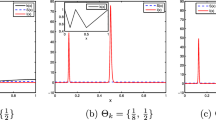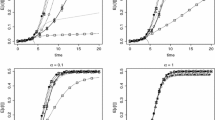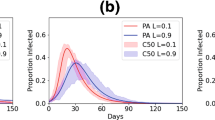Abstract
The SIR-model is a basic epidemic model that classifies a population into three subgroups: susceptible S, infected I and removed R. This model does not take into consideration the spatial distribution of each subgroup, but considers the total number of individuals belonging to each subgroup. There are many variants of the SIR-model. For studying the spatial distribution, stochastic processes have often been introduced to describe the dispersion of individuals. Such assumptions do not seem to be applicable to humans, because almost everyone moves within a small fixed radius in practice. Even if individuals do not disperse, the transmission of disease occurs. In this paper, we do not assume the dispersion of individuals, and instead use the infectious radius. Then, we propose simple continuous and discrete SIR-models that show spatial distributions. The results of our simulations show that the propagation speed and size of an epidemic depend on the population density and the infectious radius.









Similar content being viewed by others
References
Arino J, Van Den Driessche P (2003) A multi-city epidemic model. Math Popul Stud 10:175–193
Bauer F, Jost F, Liu S (2012) Ollivier–Ricci curvature and the spectrum of the normalized graph laplace operator. Math Res Lett 19:1185–1205
Berres S, Ruiz-Baier R (2011) A fully adaptive numerical approximation for a two-dimensional epidemic model with nonlinear cross-diffusion. Nonlinear Anal Real World Appl 12:2888–2903. doi:10.1016/j.nonrwa.2011.04.014
Burger R, Chowell G, Mulet PEP, Villada LM (2009) Modelling the spatial-temporal evolution of the 2009 A/H1N1 influenza pandemic in Chile. Math Biosci Eng 13:1–17
Capasso V, Di Liddo A (1994) Asymptotic behaviour of reaction-diffusion systems in population and epidemic models. J Math Biol 32:453–463. doi:10.1007/BF00160168
Chavel I (1984) Eigenvalues in Riemannian geometry. Academic press, New York
Chinviriyasit S, Chinviriyasit W (2010) Numerical modelling of an SIR epidemic model with diffusion. Appl Math Comput 216:395–409. doi:10.1016/j.amc.2010.01.028
Hilker FM, Langlais M, Petrovskii SV, Malchow H (2007) A diffusive SI model with Allee effect and application to FIV. Math Biosci 206:61–80. doi:10.1016/j.mbs.2005.10.003
Hyman JM, Laforce T (2003) Modeling the spread of influenza among cities. Bioterrorism Math Model Appl Homel Secur 28:211
Kermack WO, McKendrick AG (1927) A contribution to the mathematical theory of epidemics. In: Proceedings of the royal society a: mathematical, physical and engineering sciences. The royal society, pp 700–721
Lee JM, Choi D, Cho G, Kim Y (2012) The effect of public health interventions on the spread of influenza among cities. J Theor Biol 293:131–142. doi:10.1016/j.jtbi.2011.10.008
Lee S, Castillo-Chavez C (2015) The role of residence times in two-patch dengue transmission dynamics and optimal strategies. J Theor Biol 374:152–164. doi:10.1016/j.jtbi.2015.03.005
Lee J, Jung E (2015) A spatial-temporal transmission model and early intervention policies of 2009 A/H1N1 influenza in South Korea. J Theor Biol 380:60–73. doi:10.1016/j.jtbi.2015.05.008
Milner F, Zhao R (2008) S-I-R Model with Directed Spatial Diffusion. Math Popul Stud 15:160–181
Reluga T (2004) A two-phase epidemic driven by diffusion. J Theor Biol 229:249–261. doi:10.1016/j.jtbi.2004.03.018
Robinson M, Stilianakis NI, Drossinos Y (2012) Spatial dynamics of airborne infectious diseases. J Theor Biol 297:116–126. doi:10.1016/j.jtbi.2011.12.015
Sattenspiel L, Dietz K (1995) A structured epidemic model incorporating geographic mobility among regions. Math Biosci 128:71–91. doi:10.1016/0025-5564(94)00068-B
Sattenspiel L, Herring DA (2003) Simulating the effect of quarantine on the spread of the 1918–19 flu in central Canada. Bull Math Biol 65:1–26
Wang Y, Wang J, Zhang L (2010) Cross diffusion-induced pattern in an SI model. Appl Math Comput 217:1965–1970. doi:10.1016/j.amc.2010.06.052
Acknowledgments
The first author was supported by Basic Science Research Program through the National Research Foundation of Korea (NRF) funded by the Ministry of Education (NRF-2016R1D1A1B03931459).
Author information
Authors and Affiliations
Corresponding author
Appendix: Map of the Seoul metropolitan area and table for populations
Appendix: Map of the Seoul metropolitan area and table for populations
Figure 10 displays the map and the induced graph of the Seoul metropolitan area consisting of 33 districts, respectively. Table 1 concerns the populations of 33 districts in the Seoul metropolitan area. Figure 11 concerns the numbers of the infected between our discrete model and the spatial-temporal model of Lee and Jung (2015) for whole 33 districts.
Comparison of the cumulative numbers of the infected between our discrete model and the spatial-temporal model of Lee and Jung (2015) for 33 districts
Rights and permissions
About this article
Cite this article
Paeng, SH., Lee, J. Continuous and discrete SIR-models with spatial distributions. J. Math. Biol. 74, 1709–1727 (2017). https://doi.org/10.1007/s00285-016-1071-8
Received:
Revised:
Published:
Issue Date:
DOI: https://doi.org/10.1007/s00285-016-1071-8






